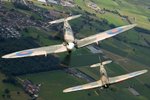Shortround6
Lieutenant General
What is a 2 stage supercharger or a 2 speed 2 stage engine?
A two stage supercharger has one supercharger outlet blowing into the inlet of a second supercharger. The required pressure being built up in two stages rather than one.
At 23,000ft or so the Merlin two stage supercharger was compressing the air about 5.2 times what normal air pressure is at that altitude. No single stage supercharger could come close to that at the time.


